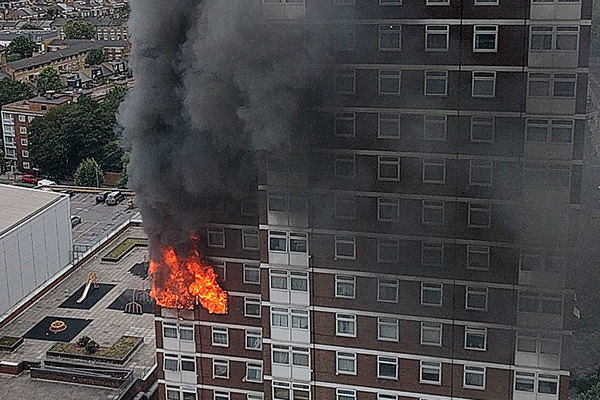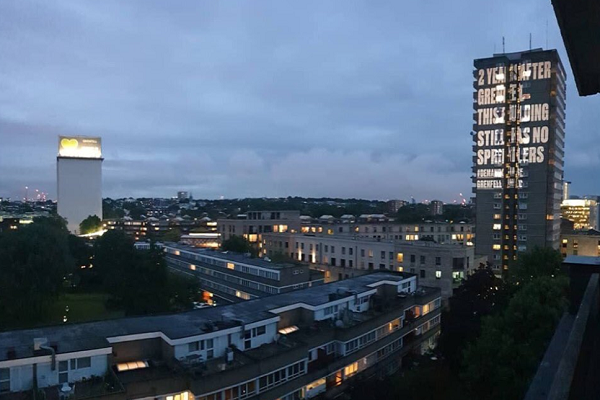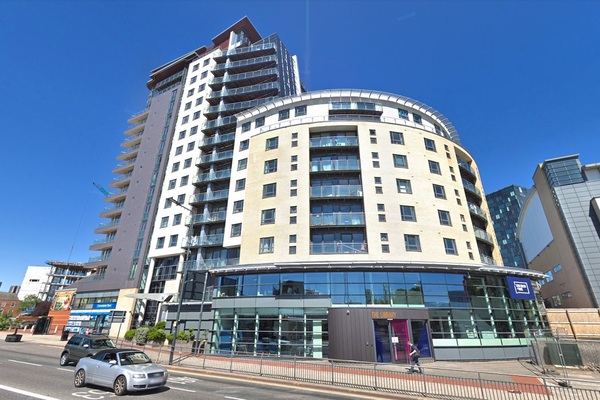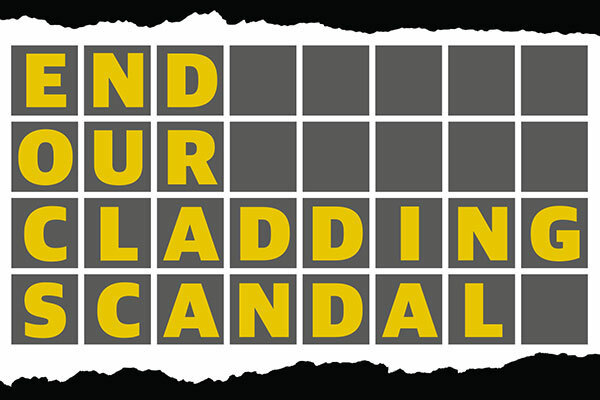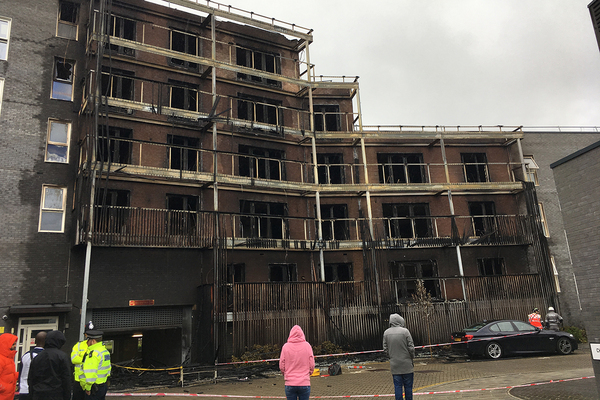End Our Cladding Scandal campaign calls on political parties to act
The End Our Cladding Scandal campaign has relaunched for the general election and calls on the next government to take action to address the “national crisis” of dangerous cladding.
The campaign, devised by Inside Housing magazine, the UK Cladding Action Group (UKCAG) and the Manchester Cladiators (who represent affected residents) calls for the next government to set up a building safety fund and a taskforce capable of taking control of the remediation programme at a national level.
Supported by Grenfell United, the National Housing Federation (NHF), the Chartered Institute of Housing and the Fire Brigades Union, it calls for a recognition that the current approach of focusing only on aluminium composite material (ACM) and buildings above 18m is not working.
Instead, the new approach would involve the taskforce identifying the most at-risk buildings of any height and material combination, which would then be prioritised for remediation work.
The relaunch of the campaign follows the fire at student accommodation The Cube in Bolton last weekend. The building had combustible high-pressure laminate cladding and was narrowly below 18m in height.
Martin Hilditch, editor of Inside Housing, said: “The issue of dangerous buildings is a national crisis and it is simply imperative that the next government commits to solving this issue before another major tragedy occurs.
Victoria Moffett, head of building and safety programmes at the NHF, said: “Following the systemic failure of building regulations revealed by the tragic Grenfell Tower fire, housing associations have been seeking professional advice, checking the safety of all their tall buildings and carrying out urgent remedial works. However, this is a huge programme of work which could take as long as a decade to complete.
“For the last two years, we have been calling on government to take a strategic lead in co-ordinating these unprecedented safety works across the country and to set up a building safety fund to pay for them. Only the government can ensure they are appropriately resourced, that the most urgent works are carried out first and speed up the process.”
“The terrible fire at Bolton at the weekend is the latest in a run of fires this year which prove the current approach is not working. All political parties should back this campaign.”
The approach is loosely modelled on work by the state government in Victoria, Australia, where a cladding taskforce has audited all 2,000 buildings in the state above three storeys, prioritised work according to risk, ensured suitable interim measures are in place, ordered building owners to carry out work and inspected its quality when completed.
End Our Cladding Scandal: campaign asks
The next government must:
- Create a ‘building safety fund’ to help pay for the necessary remediation work to affected buildings in the social and private sector – not just those with ACM cladding and above 18m
- Set up a taskforce, with the involvement of residents, capable of inspecting buildings, prioritising and ordering work and ensuring leaseholders are protected from unnecessary costs
In the UK, local authorities have been asked to provide a list of cladding materials in buildings above 18m – but this work will not complete before March 2020 and many have made limited progress.
The government has also refused to provide funding for any building that does not include ACM or is below 18m.
This means leaseholders in these buildings are facing crippling bills for remediation and there is no oversight of the work being carried out or legal obligation for building owners to act.
Jonathan O’Neill, managing director of the Fire Protection Association, said: “This has our full support. We need to start looking at this on a risk basis and if it is not properly funded the retrospective action simply will not get done.”
Ritu Saha, an affected leaseholder and a founding member of UKCAG, said: “The cladding crisis is not going away – in fact it is getting bigger, with new buildings contacting us for support every day.
“The current government approach of limiting support to buildings above 18m and clad with ACM creates a cladding lottery that has devastating consequences for the losers. Whoever forms the next government must commit to taking control of this issue before the next tragedy happens.”
Fran Reddington, an affected leaseholder and a founding member of the Manchester Cladiators, added: “In Greater Manchester alone there are dozens of buildings with dangerous cladding where there is currently no help available for residents.
“This creates a lottery which is seeing those outside the scheme asked for crippling sums to pay for the remediation work. This means stress and anxiety for residents and delayed work. We saw the potentially deadly consequences of this in Bolton last week.”
End Our Cladding Scandal general election campaign: full coverage
The cladding scandal is far from over. Here’s why we need a fresh approach
Click here to read the full story
Ahead of the general election, Inside Housing revisits our national cladding scandal and sets out what needs to be done to prevent any further tragedies. Peter Apps reports.
The cladding crisis Down Under: what we can learn from the response to Grenfell in Australia
Click here to read the full story
Five years ago a fire spread up Grenfell-style ACM cladding on a high-rise in Melbourne. This prompted an overhaul of the Australian state of Victoria’s building safety regime. Peter Apps finds out what the UK could learn.
More than 100,000 buildings outside scope of fire safety measures, minutes reveal
Click here to read the full story
There are more than 100,000 medium-rise homes that fall outside new regulations aimed at making buildings safe in the aftermath of Grenfell, including the ban on combustible cladding, Inside Housing can reveal.
It’s only a matter of time until the next Bolton unless the parties step up to the plate on fire safety
Click here to read the full story
Inside Housing’s new election campaign calls on the main political parties to commit to taking action to prevent what currently seems like an inevitable further tragedy. It’s time for everyone to step up, writes Martin Hilditch.
Leaseholders fear missing out on £200m cladding fund as bidding deadline approaches
Click here to read the full story
Leaseholders living in blocks seeking government funding for the removal of Grenfell-style cladding have raised concerns over meeting the deadline for applications, while criticising the lengthy process being run by the government.
Government refusing to test polystyrene panels, despite request from London boroughs
Click here to read the full story
The government has no further plans to carry out testing of cladding products despite a specific request from London boroughs to test systems comprising polystyrene, a document obtained by Inside Housing has revealed.
The cladding crisis in numbers
Samuel Garside House in Barking following the fire in June (picture: Nathaniel Barker)
318 buildings with dangerous Grenfell-style cladding yet to be remediated, 30 months on from the Grenfell Tower fire
15 of 184 identified private residential buildings with Grenfell-style cladding to have completed remediation work in this time
100,000 medium-rise buildings which fall outside the scope of the building safety programme introduced since Grenfell due to the 18m cut off
5,000 buildings of all heights which include some form of timber cladding
1,600 high rise or high risk buildings thought to have some form of combustible material in their external facade
600,000 residents of flats estimated to be affected by a government advice note which calls for the removal of combustible materials without providing funding or oversight of the work

